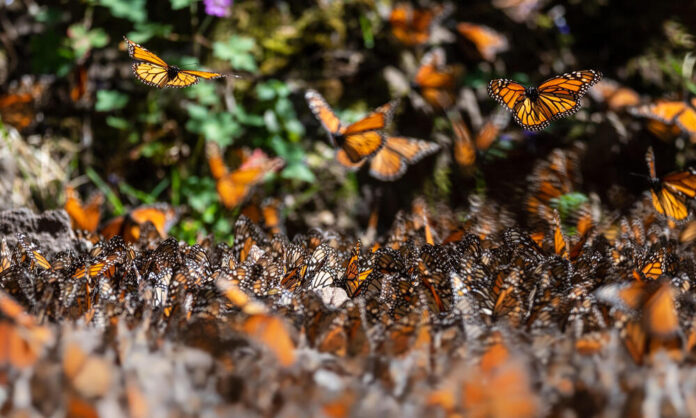Introduction
Every year, millions of monarch butterflies take part in one of the most remarkable migrations in the animal kingdom. They travel thousands of miles from Canada and the United States to the mountainous forests of Mexico, where they hibernate for the winter. In recent years, however, monarch populations have dropped dramatically, sparking concern among scientists, conservationists, and nature lovers.
The good news? Recent reports show that monarch butterflies are returning in much larger numbers than the year before. They are covering more forest area in Mexico, which means their populations may be bouncing back. This is a hopeful sign, but experts warn that the species still faces serious threats.
In this article, we’ll explore the monarch migration, the reasons behind their decline, the encouraging signs of recovery, and what all of us can do to help protect this iconic butterfly.
A Promising Return
The latest surveys reveal that monarch butterflies are occupying over three and a half times more forest area in Mexico compared to the previous winter. Scientists don’t count individual butterflies during these surveys because they cluster in dense colonies. Instead, they measure the amount of land the butterflies cover in the oyamel fir and pine forests.
While this increase is a positive sign, it’s important to remember that monarchs are still far from their historical numbers. Decades ago, they covered up to 18 hectares of forest in Mexico. Today’s numbers, though much better than last year, remain below that peak.
This rebound shows that monarchs can recover under favorable conditions. But it also highlights the urgent need to continue protecting their habitats and migration routes.
The Epic Journey of Monarch Butterflies
The monarch’s migration is nothing short of extraordinary:
- They can travel up to 3,400 miles (5,500 km) from North America to central Mexico.
- The migration is multigenerational—no single butterfly completes the entire round trip. Several generations are born, live, and die along the way.
- Monarchs use environmental cues like sunlight, the Earth’s magnetic field, and natural landmarks to navigate.
- After hibernating in Mexico, new generations gradually move north, reproducing along the way and continuing the cycle.
This incredible journey also makes monarchs extremely vulnerable to habitat loss, climate change, and other threats.
The Challenges Monarchs Still Face
Even with the recent population increase, monarch butterflies remain at risk. The biggest threats include:
1. Deforestation in Mexico
Illegal logging in the oyamel fir forests reduces the protective canopy monarchs need during winter. Without it, they become exposed to cold and wet conditions that can kill millions at once.
2. Loss of Milkweed
Milkweed is the only plant where monarchs lay their eggs, and their caterpillars depend on it for food. The widespread use of herbicides, combined with urban expansion, has destroyed vast amounts of milkweed across North America.
3. Habitat Fragmentation
Highways, cities, and large-scale farms break up the landscapes that monarchs depend on, making it harder for them to find food and safe stopover sites along their migration.
4. Climate Change and Extreme Weather
Droughts, heatwaves, and intense storms can wipe out large numbers of butterflies and damage their breeding and wintering habitats.
5. Pesticides and Pollution
Agricultural chemicals not only kill milkweed but can also poison monarchs directly.
Conservation Efforts Across Borders
Because monarchs migrate across Canada, the United States, and Mexico, protecting them requires international cooperation. Key efforts include:
- Milkweed Restoration
U.S. and Canadian initiatives are encouraging people to plant milkweed in gardens, parks, and farmlands to give monarchs more breeding grounds. - Reducing Pesticide Use
Farmers and communities are adopting eco-friendly practices to protect pollinators. - Protecting Mexican Forests
Strengthening enforcement against illegal logging and restoring degraded areas ensures monarchs have safe winter habitats. - Community and Ecotourism Programs
Local communities in Mexico benefit from ecotourism, which gives them incentives to protect the forests instead of cutting them down. - Research and Monitoring
Scientists continue to track monarch populations, study migration patterns, and predict how climate change may impact them. - Public Awareness and Education
Schools, NGOs, and governments are spreading awareness about monarchs and how everyday people can help.
How You Can Help Monarch Butterflies
Protecting monarchs isn’t only the job of governments and scientists. Everyone can play a role:
- Plant milkweed in your garden, backyard, or community space.
- Grow nectar-rich flowers to provide food for adult butterflies during migration.
- Avoid harmful pesticides that kill pollinators and their host plants.
- Support conservation groups that work on monarch and pollinator protection.
- Visit monarch sanctuaries responsibly if you travel to Mexico, ensuring that tourism supports conservation.
Even small actions add up when multiplied across communities.
Why Monarchs Matter
Monarch butterflies are more than just beautiful insects. They play key ecological, cultural, and symbolic roles:
- Pollination: Monarchs contribute to the pollination of wildflowers, supporting biodiversity.
- Environmental Indicators: Their population trends signal broader ecosystem health.
- Cultural Symbolism: In Mexico, monarchs are often linked to traditions like Día de los Muertos, representing the return of ancestors.
- Inspiration for Conservation: Their dramatic migration story inspires people worldwide to protect nature.
Looking Ahead
The recent recovery of monarch butterflies is encouraging, but their long-term survival is far from guaranteed. To ensure a stable future, conservationists stress the need for:
- Stronger international cooperation among Canada, the U.S., and Mexico.
- Expanded habitat restoration across the entire migration route.
- Adaptation strategies for climate change, such as protecting alternative wintering sites.
- Continued education and engagement to keep the public invested in monarch conservation.
The monarch’s survival depends on sustained, collective action.
Conclusion
The return of monarch butterflies “in a big way” is a hopeful reminder of nature’s resilience. When favorable conditions align with human efforts to protect them, monarchs show us that recovery is possible.
Still, their future remains fragile. Deforestation, habitat loss, climate change, and pesticides are ongoing threats that could undo progress if left unchecked. Protecting monarchs is not just about saving a butterfly species—it’s about preserving ecosystems, cultural traditions, and the natural balance we all depend on.
By planting milkweed, supporting conservation, and spreading awareness, each of us can contribute to ensuring that the monarch migration continues to inspire future generations.
Frequently Asked Questions (FAQs)
1. Why do scientists measure monarchs by forest area instead of counting individuals?
Because monarchs cluster tightly together in colonies, it’s nearly impossible to count them individually. Measuring the hectares of forest they occupy is more accurate.
2. How far do monarch butterflies travel during migration?
Some monarchs travel up to 3,400 miles (5,500 km) from Canada and the northern U.S. to Mexico.
3. Why is milkweed essential for monarchs?
Milkweed is the only plant where monarchs lay their eggs, and their caterpillars feed exclusively on it. Without milkweed, they cannot reproduce.
4. What role does Mexico play in the monarch’s life cycle?
Mexico’s oyamel fir forests provide the perfect microclimate for monarchs to survive winter. Protecting these forests is critical for their survival.
5. How can I help monarchs if I don’t live along their migration path?
You can plant milkweed and nectar flowers, avoid pesticides, and support organizations dedicated to pollinator conservation.
6. Does this population rebound mean monarchs are no longer at risk?
Not yet. Although their numbers are improving, they are still far below historical levels. Long-term conservation is needed.


